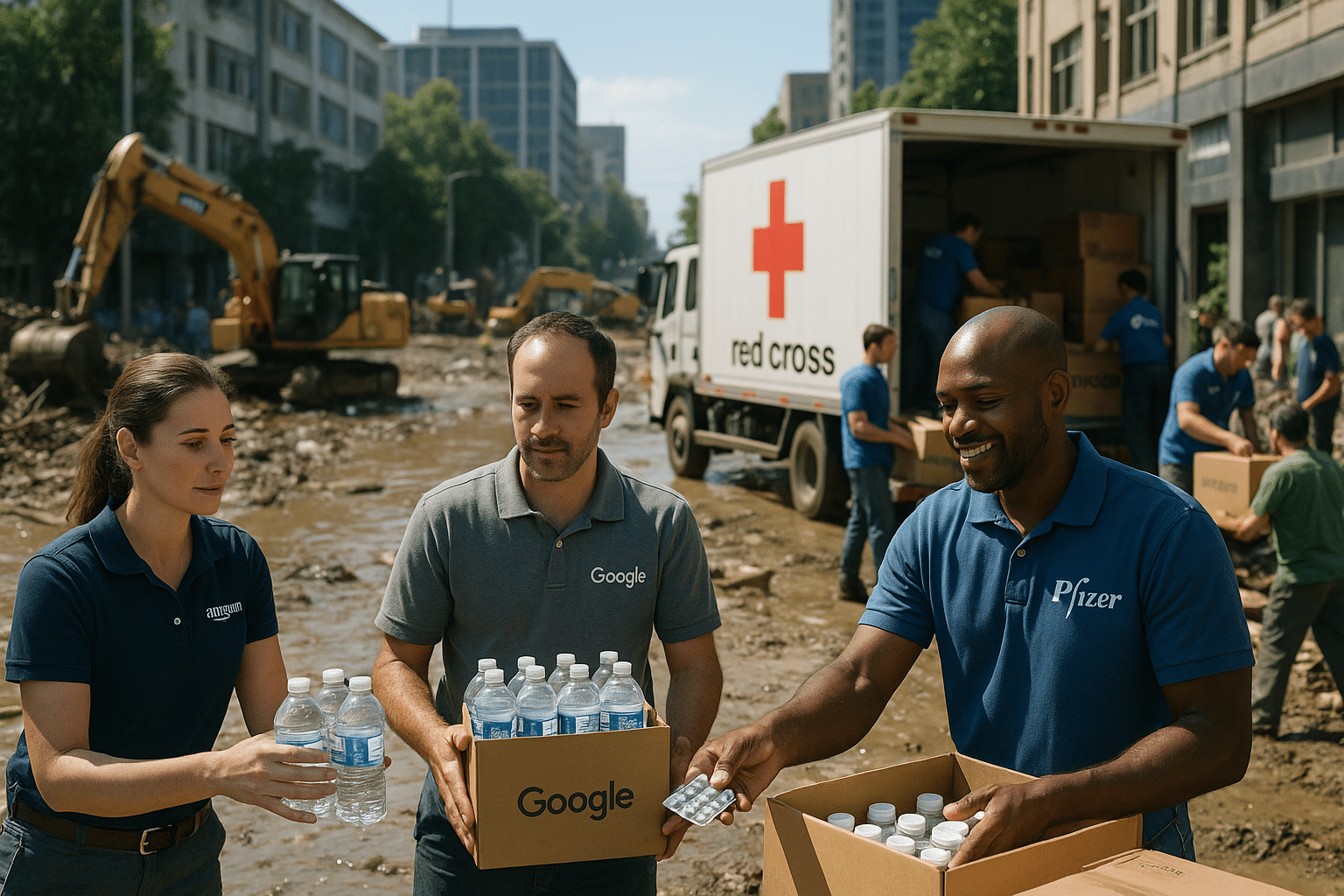Today, we find ourselves at the confluence of commerce and compassion, where businesses are leveraged as agents of change to alleviate societal woes. One significant manifestation of this amalgamation is the evolving role of Corporate Social Responsibility (CSR) in disaster response efforts.
Historically, disaster management has been primarily the domain of government bodies, humanitarian organizations, and non-profits. 🌍 But, as the frequency and intensity of disasters escalate, the need for a collective response has become more critical than ever. It is at this juncture that corporations, with their expansive resources and global reach, can play a transformative role. So, let’s delve deeper into the concept of “Corporate Compassion” and how CSR initiatives are revolutionizing disaster response efforts.
Understanding Corporate Compassion and CSR
Let’s start by demystifying Corporate Compassion and Corporate Social Responsibility. Corporate Compassion refers to the empathetic actions businesses take to alleviate societal issues, be it poverty, education, or disaster management. These actions often fall under the umbrella of Corporate Social Responsibility, which encapsulates a company’s commitment to ethical practices that benefit society.
From an existential standpoint, the essence of CSR lies in the belief that businesses can, and should, contribute towards a greater social good. 💡 This perspective is becoming increasingly prevalent, with more businesses recognizing their role as global citizens and consequently integrating CSR into their core strategy.
The Intersection of CSR and Disaster Response
Disaster response and recovery is a critical area where CSR initiatives can make a significant impact. The scope and severity of disasters demand a multi-faceted response, and corporations, with their plethora of resources, can help fill the gap. From providing financial support and essential supplies to deploying technologies for rescue and rehabilitation, the potential for corporate intervention is vast and varied.
What’s more, the benefits of CSR-led disaster response initiatives are not confined to the immediate aftermath of disasters. Many CSR programs focus on long-term recovery and resilience building, thereby playing a crucial role in a community’s overall disaster management strategy. 🏡
Looking Ahead: The Future of CSR in Disaster Response
In the forthcoming sections, we will discuss in detail the role of CSR initiatives in disaster response efforts, exploring case studies of companies that have made significant contributions. We will also discuss how these initiatives are not only aiding communities but also reshaping the very landscape of corporate responsibility.
From enhanced brand reputation to stronger community ties, the benefits of CSR initiatives extend beyond immediate disaster relief. As we navigate through these discussions, we will uncover how CSR initiatives are not just a charitable obligation, but an integral part of a sustainable business strategy. 💼
Join us as we venture into this remarkable fusion of business acumen and social compassion, where corporations emerge as key players in disaster response efforts, contributing not just to the bottom line, but also to the betterment of society at large.
Unlocking the Power of Corporate Compassion: A Deep Dive into CSR and Disaster Response
Amid the alarming increase in natural disasters and humanitarian crises, the role of Corporate Social Responsibility (CSR) in disaster response has become increasingly significant. Companies worldwide are stepping up, leveraging their resources, skills, and influence to support affected communities in times of need. Let’s take an in-depth look at how CSR initiatives are revolutionizing disaster response efforts.
But first, what exactly is CSR? Corporate Social Responsibility refers to a business model that helps companies become socially accountable. It’s a self-regulating model that allows a company to be socially accountable to itself, its stakeholders, and the public. By practicing corporate social responsibility, companies can be conscious of the kind of impact they are having on all aspects of society, including economic, social, and environmental.
To better understand the impact of CSR on disaster response, let’s examine some examples of companies that have successfully used their CSR initiatives to aid in disaster recovery and resilience. Furthermore, to give you a clear picture, we’ll contrast these examples with traditional disaster response methods.
Comparing Traditional Disaster Response with CSR-Driven Disaster Response
| Traditional Disaster Response | CSR-Driven Disaster Response |
| Relies primarily on government agencies and NGOs. | Engages businesses in the process, fostering a multi-sectoral approach. |
| Limited resources can sometimes delay recovery efforts. | Businesses can leverage their resources to provide immediate relief. |
| Focuses on immediate relief, often overlooking long-term recovery and resilience. | Focuses on both immediate relief and long-term recovery, often through sustainability initiatives. |
To see this in action, take a look at the following video: “Corporate Compassion: Businesses Respond to Natural Disasters” by ABC News.
Inspiring Examples of Corporate Compassion in Action
The past few years have seen a surge of corporate compassion, with many companies going beyond their CSR mandates to support disaster response efforts. Here are a few inspiring examples.
Google: Tech-Powered Disaster Response
Google has been at the forefront of using technology for disaster response. In 2017, during Hurricane Harvey, Google activated its Crisis Response team, which provided real-time, life-saving information through Google Maps and Search. They also matched donations to relief organizations, contributing over $1 million in funds.
Starbucks: Turning Stores into Relief Hubs
Starbucks is known for its proactive response to disasters. During Hurricane Maria in Puerto Rico, Starbucks stores became community hubs, providing water, electricity, and internet. Their employees voluntarily served coffee and food to relief workers and survivors. In addition, Starbucks committed $250,000 for recovery efforts.
Walmart: Leveraging Supply Chain for Disaster Response
Walmart has consistently utilized its vast resources and supply chain capabilities in disaster response. Post-Hurricane Katrina, they donated $20 million in cash, 1,500 truckloads of free merchandise, and food for 100,000 meals. They also used their logistics network to ensure rapid delivery of supplies.
These examples highlight how companies can harness their unique capabilities to support disaster response. From leveraging technology to utilizing supply chains, CSR-driven disaster response presents a myriad of opportunities for businesses to make a meaningful impact. Watch this informative video: “Corporate Compassion: The Role of Businesses in Disaster Response” by CNBC, for a deeper insight.
Transforming Disaster Response: The Way Forward
The shift towards CSR-driven disaster response marks a significant step in our collective approach to tackling crises. By engaging the private sector, we can tap into a wealth of resources and innovative solutions that can significantly enhance disaster response efforts.
However, there are still challenges that need to be addressed. For instance, aligning corporate interests with humanitarian needs, ensuring transparency in CSR activities, and building partnerships between businesses and disaster response agencies.
Addressing these challenges requires a collaborative approach, involving governments, NGOs, businesses, and communities. It’s not just about providing financial aid, but about leveraging unique skills and capabilities to support long-term recovery and resilience. To gain further insights into this topic, tune into this insightful video: “The Future of Corporate Social Responsibility” by TEDx Talks.
In a world increasingly vulnerable to crises, the role of corporate compassion in disaster response cannot be underestimated. Through strategic CSR initiatives, businesses can play a crucial role in shaping a more resilient future.
Embrace Corporate Compassion: Make a Difference Today
Corporate compassion is more than just a buzzword; it’s a powerful tool that can drive meaningful change. Whether it’s through donating funds, providing resources, or leveraging technology, businesses have the potential to significantly enhance disaster response efforts.
If you are a business leader, consider how you can integrate CSR into your disaster response strategy. Remember, your actions can make a significant difference in the lives of those affected by disasters.
Take a moment to watch this inspiring video: “The Power of Corporate Compassion: Stories from the Frontlines” by Business Insider, and see how businesses are making a real difference in disaster-stricken communities.

Conclusion
In conclusion, we have traversed the challenging but exciting landscape of Software Engineering and IT, delving into its complexities and surfacing with a deeper understanding. We’ve explored the dynamic synergy between software development processes, system analysis, and design strategies, emphasizing their importance in the context of modern technology.
We have dissected the significance of the software development lifecycle (SDLC), stressing the fact that the success of any software project is closely tied to a robust and efficient SDLC. A strong SDLC framework ensures that software development is organized, systematic, and tailored to meet the specific needs of the end-user.
We have also highlighted the role of systems analysis in understanding and articulating the needs of the end-user. Systems analysis is integral in bridging the gap between the technical and non-technical elements of a project, fostering effective communication and ensuring that the software solution aligns with the objectives of the stakeholders.
Moreover, we examined the nuances of design strategies, looking at both architectural and detailed design. We stressed the importance of a well-structured design strategy in providing a roadmap for developers, ensuring that the final product is efficient, secure, and easy to maintain.
Now, this isn’t just another article that you read, nod, and move on. It is a call to action. It’s an invitation to reflect on your practices, evaluate your processes, and if necessary, make improvements. It’s a challenge to elevate your game, to strive for efficiency and effectiveness in all that you do. Whether you’re a seasoned software engineer or a novice just starting out, there’s always room to learn, to grow, and to excel.
I encourage you to share your thoughts in the comments below. Let’s engage in a vibrant conversation, learning from each other and contributing to the collective wisdom of the community. Share this article with your colleagues, peers, and friends. You never know, it might just be the insight they’ve been searching for.
And, let’s not forget that learning is a never-ending journey. Always be open to new ideas, be curious, and never stop exploring. 🚀
Stay tuned for more deep dives into the world of Software Engineering and IT. Until next time, keep learning, keep growing, and keep pushing the boundaries of what’s possible.
[Reference](http://www.example.com)
Tags: #SoftwareEngineering #IT #SDLC #SystemsAnalysis #DesignStrategies



